
Once the basic finger spelling is mastered, the diacritic hiragana with
two dashes (like ga, ki, za, do, and be) and one circle (like pa, pu, pi,
pe, and po) are easy. The more complicated combinations such as double
consonant forms (for example the word "truck" (torakku in Romaji)) and contracted forms (for example
"cat" (kyatto in Romaji) may be a little more of a challenge
because of the multiple signs needed to denote a single sound. Also covered is
the lengthening of a sound which is fairly simple as well. Lastly, a practice
example is given that uses all these modified hand forms.
|
濁音(dakuon - Diacritic)
| All one does to express the two dashes modification is to start the sign a little to the left of where the normal sign would be (if done with the right hand) and move it to the right. So, if someone wanted to express the sign for ga, it would look like this: |
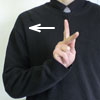
 |
| が ガ ga |
First Position (a little to the left of the static hand form).
End Position (the modified form ends in the "ka" static position
denoting "ga"). |
|
|
半濁音(handakuon - P sounds)
The P sound forms are just raised from the standard position to create their modified form:
|
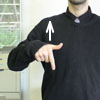
 |
| ぷ プ pu |
First Position (This is just the standard form of the symbol).
End Position (The standard form is just raised from its static position
sharply to create the one circle form). |
|
| With that in mind, why don't you practice the following a little to get the hang of the diacritic forms? |
促音(sokuon - Double Consonant Forms)
| Double consonant words, such as the word "truck" ("torakku" in Romaji) demonstrated in the example shown here use a modified "tsu" hand form to represent the doubled consonant. |
 |
| と ト to |
|
|
 |
| ら ラ ra |
|
|

 |
| っ ッ tsu |
| The sign is pulled back toward the body. |
|
 |
| く ク ku |
|
|
|
拗音(youon - Contracted Forms)
| Words that require contracting syllables, like cat (kyatto in Romaji) are
signed in a similar way as double consonants. In the katakana form of cat
(kyatto), the kya sound is made up of the hand form for "ki"
and a modified hand form of "ya" as seen it the following example: |
 |
| き キ ki |
|
|

 |
| ゃ ャ ya |
| The "ya" sign is pulled back toward the body. |
|

 |
| っ ッ tsu |
| The "tsu" sign is pulled back toward the body. |
|
 |
| と ト to |
|
|
|
長音(chouon - Lengthened Sound)
| There are also some words that require a lengthening of certain sounds, like in New Zealand ("nyu-ji-rando" in Romaji) in order to accurately denote their proper pronunciation. This is done by drawing a vertical line in the air after the syllable that needs to be lengthened like in the following example: |
 |
| に ニ ni |
|
|
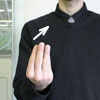
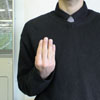 |
| ゅ ュ yu |
| The sign is pulled back toward the body. |
|
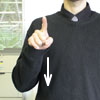
 |
| − |
| This sign lenghthens the "yu" sound. |
|
|
|
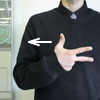
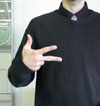 |
| じ ジ ji |
| "shi" is modified to sign "ji". |
|
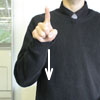
 |
| − |
| This sign lenghthems the "ji" sound. |
|
 |
| ら ラ ra |
|
|
|
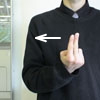
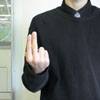 |
| ど ド do |
| "to" is modified to sign "do". |
|
| Both of the above techniques are used to express the word "shortcut"
(sho-to katto in Romaji) looking like what is done in this example: |
 |
| し シ shi |
|
|

 |
| ょ ョ yo |
| The "yo" sign is pulled back toward the body. |
|

 |
| − |
| This sign is made after "sho" to lengthens its sound to. |
|
 |
| と ト to |
|
|
|
 |
| か カ ka |
|
|

 |
| っ ッ tsu |
| The "tsu" sign is pulled back toward the body. |
|
 |
| と ト to |
|
|
|
|
|
|